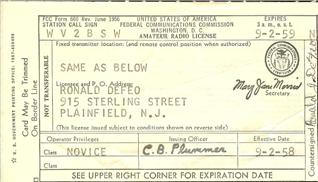My call sign and Ham Radio history
Call Sign History –
After receiving my vanity call in early March 2012, I became interested in its history. An article in the May 1994 issue of QST indicates that K call signs were first introduced in 1947 for the 9th call area only. It appears from the same article that K calls were issued in other call areas in the mid 1950. (I did not miss by much in receiving a KN call for my Novice license).
The FCC web site showed the previous holder of the call was William F. Wiebe (Palm Beach, Fla). The Call Book information I have indicates that the call was assigned to him from some time in 1976 until I obtained it in 2012. Prior to that Robert Pierce (Jacksonville, Fla) held the call from 1968 until 1974 or 1975. So far I can not see that the call was assigned prior to 1968.
More research to follow.
Notes:
- As part of Incentive Licensing on or after November 22, 1967 a two letter call could be requested if the ham held a US license for at least 25 years and holds an Extra Class. No special combination of letter were offered.
- Docket 20092 effective July 1, 1976 allowed any Extra Class licensee to request a specific 1X2 call.
- The Call Book information was found on archive.org.
My Ham Radio history –
One day in late 1957 or early 1958 a friend and I came up with the idea to get into Ham Radio. To this day I do not know how this came into our heads, but off we went to get our tickets. My friend moved away before we got licensed and shortly thereafter we lost track of each other. In the late 1950’s to a 13 year old kid 50 miles and a state away might as well be on the moon. My first license, Novice class, was issued on September 2, 1958 (copy below). Unlike most hams you read about on the web, my Novice year was a bust. For some unknown reason I stuck with it and passed my Technician class test (finally). That was when I made contact with an Elmer (a ham who worked with my father). He was Jack – K2IUK. I built a six meter crystal controlled transmitter and Jack made it work. Add a modulator he lent me and a converter another friend of my father’s built and six meter AM became my home for the next year plus. After meeting a newly minted novice with a very nice Eico 720 transmitter I experienced the success on the Novice HF CW bands that I had missed. That was all it took for me to study and make the trip to 641 Washington Street New York City to take my General test. Passed on the first try (a new concept). Back in those days a General ticket gave you access to all Amateur Radio frequencies. (I will not get on a soapbox about “incentive” licensing and the about face of today.) In the mid 1970’s after acquiring my first modern SSB equipment I spent most of my time on phone. Therefore, in February 1980 I upgraded to the Advance Class license to get some of my old phone operating privileges back. Passing on the first time was a thing of the past. In fact I took the test in New York City and Chicago before a return trip to New York yielded a passing grade. Revisiting CW and being bitten my the DX bug I decided to upgrade to extra to get the low end of 40 and 20 Meters back. Determined to make only one trip to the test site (easier trip with the VE Program), I studied like crazy. On 26 February 2006, I took and passed my Extra Class test (okay, studying worked as I passed on the first try and I aced it!)
